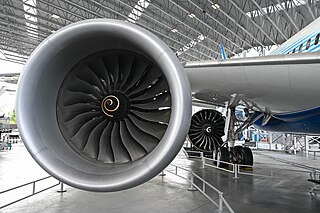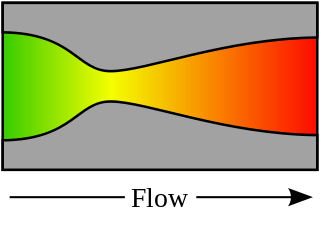
A jet engine is a type of reaction engine, discharging a fast-moving jet of heated gas that generates thrust by jet propulsion. While this broad definition may include rocket, water jet, and hybrid propulsion, the term jet engine typically refers to an internal combustion air-breathing jet engine such as a turbojet, turbofan, ramjet, pulse jet, or scramjet. In general, jet engines are internal combustion engines.

A rocket is a vehicle that uses jet propulsion to accelerate without using the surrounding air. A rocket engine produces thrust by reaction to exhaust expelled at high speed. Rocket engines work entirely from propellant carried within the vehicle; therefore a rocket can fly in the vacuum of space. Rockets work more efficiently in a vacuum and incur a loss of thrust due to the opposing pressure of the atmosphere.

Spacecraft propulsion is any method used to accelerate spacecraft and artificial satellites. In-space propulsion exclusively deals with propulsion systems used in the vacuum of space and should not be confused with space launch or atmospheric entry.
A resistojet is a method of spacecraft propulsion that provides thrust by heating a typically non-reactive fluid. Heating is usually achieved by sending electricity through a resistor consisting of a hot incandescent filament, with the expanded gas expelled through a conventional nozzle.
A pulsed plasma thruster (PPT), also known as a plasma jet engine, is a form of electric spacecraft propulsion. PPTs are generally considered the simplest form of electric spacecraft propulsion and were the first form of electric propulsion to be flown in space, having flown on two Soviet probes starting in 1964. PPTs are generally flown on spacecraft with a surplus of electricity from abundantly available solar energy.

An antimatter rocket is a proposed class of rockets that use antimatter as their power source. There are several designs that attempt to accomplish this goal. The advantage to this class of rocket is that a large fraction of the rest mass of a matter/antimatter mixture may be converted to energy, allowing antimatter rockets to have a far higher energy density and specific impulse than any other proposed class of rocket.
Specific impulse is a measure of how efficiently a reaction mass engine, such as a rocket using propellant or a jet engine using fuel, generates thrust. For engines like cold gas thrusters whose reaction mass is only the fuel they carry, specific impulse is exactly proportional to the effective exhaust gas velocity.
Delta-v, symbolized as and pronounced deltah-vee, as used in spacecraft flight dynamics, is a measure of the impulse per unit of spacecraft mass that is needed to perform a maneuver such as launching from or landing on a planet or moon, or an in-space orbital maneuver. It is a scalar that has the units of speed. As used in this context, it is not the same as the physical change in velocity of said spacecraft.

A rocket engine uses stored rocket propellants as the reaction mass for forming a high-speed propulsive jet of fluid, usually high-temperature gas. Rocket engines are reaction engines, producing thrust by ejecting mass rearward, in accordance with Newton's third law. Most rocket engines use the combustion of reactive chemicals to supply the necessary energy, but non-combusting forms such as cold gas thrusters and nuclear thermal rockets also exist. Vehicles propelled by rocket engines are commonly used by ballistic missiles and rockets. Rocket vehicles carry their own oxidiser, unlike most combustion engines, so rocket engines can be used in a vacuum to propel spacecraft and ballistic missiles.
A propellant is a mass that is expelled or expanded in such a way as to create a thrust or another motive force in accordance with Newton's third law of motion, and "propel" a vehicle, projectile, or fluid payload. In vehicles, the engine that expels the propellant is called a reaction engine. Although technically a propellant is the reaction mass used to create thrust, the term "propellant" is often used to describe a substance which contains both the reaction mass and the fuel that holds the energy used to accelerate the reaction mass. For example, the term "propellant" is often used in chemical rocket design to describe a combined fuel/propellant, although the propellants should not be confused with the fuel that is used by an engine to produce the energy that expels the propellant. Even though the byproducts of substances used as fuel are also often used as a reaction mass to create the thrust, such as with a chemical rocket engine, propellant and fuel are two distinct concepts.

A de Laval nozzle is a tube which is pinched in the middle, making a carefully balanced, asymmetric hourglass shape. It is used to accelerate a compressible fluid to supersonic speeds in the axial (thrust) direction, by converting the thermal energy of the flow into kinetic energy. De Laval nozzles are widely used in some types of steam turbines and rocket engine nozzles. It also sees use in supersonic jet engines.

Jet propulsion is the propulsion of an object in one direction, produced by ejecting a jet of fluid in the opposite direction. By Newton's third law, the moving body is propelled in the opposite direction to the jet. Reaction engines operating on the principle of jet propulsion include the jet engine used for aircraft propulsion, the pump-jet used for marine propulsion, and the rocket engine and plasma thruster used for spacecraft propulsion. Underwater jet propulsion is also used by several marine animals, including cephalopods and salps, with the flying squid even displaying the only known instance of jet-powered aerial flight in the animal kingdom.
Regenerative cooling, in the context of rocket engine design, is a configuration in which some or all of the propellant is passed through tubes, channels, or in a jacket around the combustion chamber or nozzle to cool the engine. This is effective because the propellants are often cryogenic. The heated propellant is then fed into a special gas-generator or injected directly into the main combustion chamber.

A rocket engine nozzle is a propelling nozzle used in a rocket engine to expand and accelerate combustion products to high supersonic velocities.
A reaction engine is an engine or motor that produces thrust by expelling reaction mass, in accordance with Newton's third law of motion. This law of motion is commonly paraphrased as: "For every action force there is an equal, but opposite, reaction force."
Characteristic velocity or , or C-star is a measure of the combustion performance of a rocket engine independent of nozzle performance, and is used to compare different propellants and propulsion systems. c* should not be confused with c, which is the effective exhaust velocity related to the specific impulse by: . Specific impulse and effective exhaust velocity are dependent on the nozzle design unlike the characteristic velocity, explaining why C-star is an important value when comparing different propulsion system efficiencies. c* can be useful when comparing actual combustion performance to theoretical performance in order to determine how completely chemical energy release occurred. This is known as c*-efficiency.

Rocket propellant is the reaction mass of a rocket. This reaction mass is ejected at the highest achievable velocity from a rocket engine to produce thrust. The energy required can either come from the propellants themselves, as with a chemical rocket, or from an external source, as with ion engines.
A thermal rocket is a rocket engine that uses a propellant that is externally heated before being passed through a nozzle to produce thrust, as opposed to being internally heated by a redox (combustion) reaction as in a chemical rocket.

The KTDU-80 (Russian: Корректирующе-Тормозная Двигательная Установка, КТДУ) is the latest of a family of integrated propulsion system that KB KhIMMASH has implemented for the Soyuz since the Soyuz-T. It integrates main propulsion, RCS and attitude control in a single system pressure fed from a common dual string redundant pressurized propellant system. The common propellant is UDMH and N2O4 and the main propulsion unit, is the S5.80 main engine. It generates 2.95 kN (660 lbf) of thrust with a chamber pressure of 880 kPa (128 psi) and a nozzle expansion of 153.8 that enables it to achieve a specific impulse of 302 s (2.96 km/s). It is rated for 30 starts with a total firing time of 890 seconds. The integrated system without the pressurization or tanks weighs 310 kg (680 lb); it is 1.2 m (47 in) long with a diameter of 2.1 m (83 in).
Microwave electrothermal thruster, also known as MET, is a propulsion device that converts microwave energy into thermal energy. These thrusters are predominantly used in spacecraft propulsion, more specifically to adjust the spacecraft’s position and orbit. A MET sustains and ignites a plasma in a propellant gas. This creates a heated propellant gas which in turn changes into thrust due to the expansion of the gas going through the nozzle. A MET’s heating feature is like one of an arc-jet ; however, due to the free-floating plasma, there are no problems with the erosion of metal electrodes, and therefore the MET is more efficient.
























